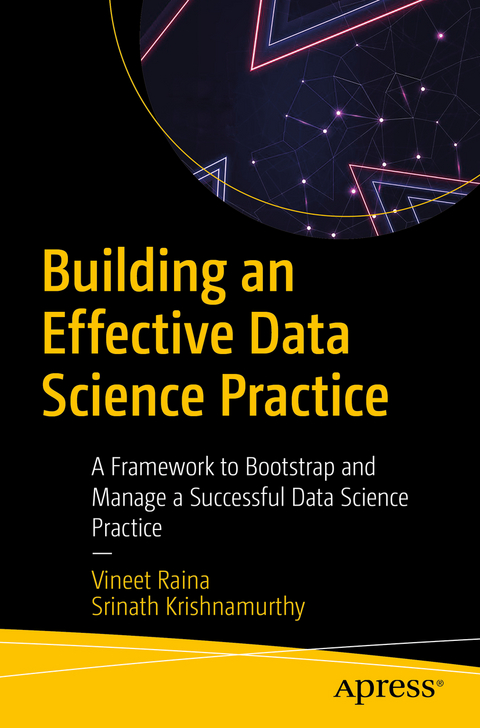
Building an Effective Data Science Practice
Apress (Verlag)
978-1-4842-7418-7 (ISBN)
You’ll start by delving into the fundamentals of data science – classes of data science problems, data science techniques and their applications – and gradually build up to building a professional reference operating model for a data science function in an organization. This operating model covers the roles and skills required in a team, the techniques and technologies they use, and the best practices typically followed in executing data science projects.
Building an Effective Data Science Practice provides a common base of reference knowledge and solutions, and addresses the kinds of challenges that arise to ensure your data science team is both productive and aligned with the business goals from the very start. Reinforced with real examples, this book allows you to confidently determine the strategic answers to effectively align your business goals with the operations of the data science practice.
What You’ll Learn
Transform business objectives into concrete problems that can be solved using data science
Evaluate how problems and the specifics of a business drive the techniques and model evaluation guidelines used in a project
Build and operate an effective interdisciplinary data science team within an organization
Evaluating the progress of the team towards the business RoI
Understand the important regulatory aspects that are applicable to a data science practice
Who This Book Is For
Technology leaders, data scientists, and project managers
Vineet is a Chief Data Scientist at GS Lab, India, and has led the effort of setting up a Data Science group at GS Lab which has now successfully executed Data Science projects in diverse fields like healthcare, IoT, communication, etc. He has also led research projects - in Computer Vision and Demand Forecasting, and developed new Data Science algorithms/techniques in areas like model performance tuning.Vineet is a computer science engineer from Pune university with a master’s degree from BITS Pilani. For most of his 17-year professional career, he has been associated with Data Science projects and has 2 US patents in his name. Prior to joining GS Lab, he worked at SAS for 7 years building data science products. He has presented papers in global conferences and has given talks in colleges on topics related to Data Science. He has also been associated with universities for research projects in the field of Data Science. Srinath is a Principal Architect at GS Lab, India. His key responsibility has been to bootstrap, and now to lead, the Data Science capability in GS Lab. A TOGAF9-certified architect, Srinath specializes in aligning business goals to the technical roadmap and data strategy for his clients. His typical clients are software technology companies that depend on data science, or enterprises looking to leverage data science as part of their digitalization programs. Srinath is a computer-science graduate from Pune University. During his 17 years of professional experience, he has primarily worked on data mining, predictive modeling, and analytics in varied areas such as CRM (retail/finance), life-sciences, healthcare, video conferencing, industrial-IoT and smart cities.
Part One: Fundamentals.- 1. Introduction: The Data Science Process.- 2. Data Science and your business .- 3. Monks vs. Cowboys: Data Science Cultures.- Part Two: Classes of Problems.- 4. Classification .- 5. Regression.- 6. Natural Language Processing .- 7. Clustering.- 8. Anomaly Detection.- 9.Recommendations.- 10. Computer Vision.- 11. Sequential Decision Making.- .- Part Three: Techniques & Technologies.- 12. Overview.- 13. Data Capture.- 14. Data Preparation.- 15. Data Visualization.- 16. Machine Learning.- 17. Inference.- 18. Other tools and services.- 19. Reference Architecture.- 20. Monks vs. Cowboys: Praxis.- Part Four: Building Teams and Executing Projects.- 21. The Skills Framework.- 22. Building and structuring the team.- 23. Data Science Projects.- Appendix FAQs.
| Erscheinungsdatum | 20.12.2021 |
|---|---|
| Zusatzinfo | 28 Illustrations, color; 71 Illustrations, black and white; XXVI, 368 p. 99 illus., 28 illus. in color. |
| Verlagsort | Berkley |
| Sprache | englisch |
| Maße | 155 x 235 mm |
| Themenwelt | Mathematik / Informatik ► Informatik ► Datenbanken |
| Informatik ► Theorie / Studium ► Algorithmen | |
| Informatik ► Theorie / Studium ► Künstliche Intelligenz / Robotik | |
| Schlagworte | data engineering • Data Science • Deep learning • machine learning • ML Ops |
| ISBN-10 | 1-4842-7418-0 / 1484274180 |
| ISBN-13 | 978-1-4842-7418-7 / 9781484274187 |
| Zustand | Neuware |
| Informationen gemäß Produktsicherheitsverordnung (GPSR) | |
| Haben Sie eine Frage zum Produkt? |
aus dem Bereich


